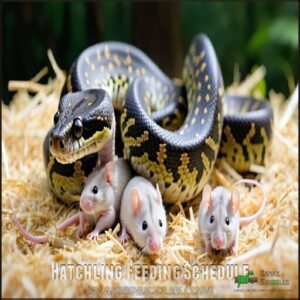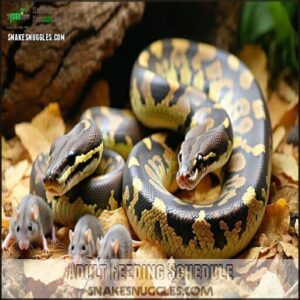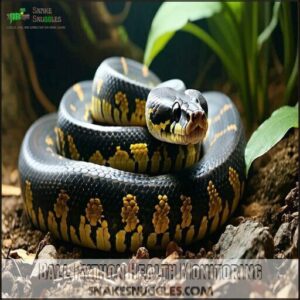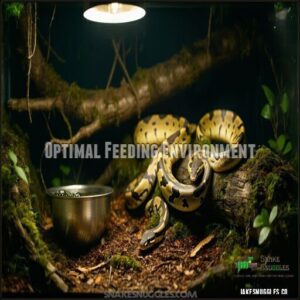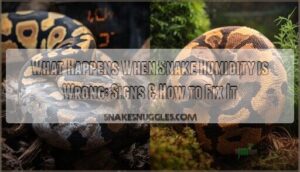This site is supported by our readers. We may earn a commission, at no cost to you, if you purchase through links.
 You should feed your ball python 1-3 appropriately-sized mice every 7-14 days, depending on its age and size.
You should feed your ball python 1-3 appropriately-sized mice every 7-14 days, depending on its age and size.
Young pythons need smaller prey more often (every 5-7 days), while adults can go longer between meals (10-14 days).
The right mouse should create a small bulge in your snake’s midsection—not too big, not too small, like Goldilocks, your python needs things just right.
A juvenile might eat one adult mouse weekly, while mature pythons may handle larger prey less frequently, and proper feeding supports healthy growth and prevents obesity.
Specific weight-to-prey ratios can make all the difference in your snake’s long-term health.
Table Of Contents
- Key Takeaways
- Ball Python Feeding Basics
- How Many Mice to Feed
- Ball Python Growth Stages
- Feeding Schedule Factors
- Prey Size and Type
- Feeding Mistakes to Avoid
- Ball Python Digestion Time
- Feeding During Shedding
- Ball Python Health Monitoring
- Optimal Feeding Environment
- Frequently Asked Questions (FAQs)
- How often do ball pythons eat mice?
- How to feed a ball python a mouse?
- How many mice do ball pythons need?
- How much should a ball python eat?
- How often should a ball python eat a rat?
- Do ball pythons need a feeding chart?
- How many mice do ball pythons eat a day?
- How much should you feed a ball python?
- Should I feed my ball python live mice?
- How often should I feed snakes mice?
- Conclusion
Key Takeaways
- Feed your ball python based on its size and age—hatchlings every 5-7 days, juveniles every 10-14 days, and adults every 2-3 weeks.
- Choose prey that’s slightly smaller than your snake’s widest girth to ensure safe digestion and proper nutrition.
- Always use frozen-thawed prey instead of live mice to reduce injury risks and stress for your snake.
- Monitor your snake’s weight and appetite to adjust feeding schedules and avoid obesity or underfeeding.
Ball Python Feeding Basics
Feeding your ball python starts with understanding its dietary needs, like choosing the right prey type, size, and feeding schedule.
Sticking to these basics guarantees your snake stays healthy and grows properly.
Choosing Prey Type
Choosing the right prey type for your ball python guarantees it thrives in captivity. Mice and rats are staple options, offering nutritional completeness while mimicking their wild diet.
Always opt for frozen-thawed prey, as it’s safer and reduces injury risks compared to live feeding. Consider adding some rodent variety to their diet for balance.
For quality options, consider prey from trusted sources. Stick to trusted suppliers for prey availability and quality.
- Frozen-thawed mice and rats prevent injuries and are cost-effective.
- Occasional alternatives like chicks or hamsters provide variety but shouldn’t replace staples.
- Avoid live feeding—it’s risky and can stress or harm your snake.
Importance of Prey Size
Getting the prey size right is key to your ball python’s health and happiness.
The prey’s diameter should match your snake’s widest point for smooth digestion and proper nutrition. Rodents that are too small won’t satisfy your snake, while oversized prey can lead to impaction risks or regurgitation.
- Why it matters:
- Digestion efficiency: Prevents regurgitation and helps nutrient absorption.
- Nutritional balance: Supports steady growth rates.
- Feeding success: Snakes instinctively prefer prey that ‘fits.’
Follow feeding guidelines closely and always monitor your python after meals to confirm it digests properly and thrives on appropriately sized mice. To guarantee safety, it’s best to use frozen-thawed prey rather than live.
Feeding Frequency Guidelines
Feeding frequency for ball pythons varies by age and size to match their growth rate and energy needs.
Hatchlings eat every 5-7 days to support rapid growth, juveniles every 10-14 days during development, and adults every 14-21 days to maintain health without risking obesity.
Adjust feeding frequency as needed for individual variation, seasonal changes, or breeding cycles. Monitor your snake’s appetite and weight to refine your schedule.
| Age Group | Feeding Frequency | Notes |
|---|---|---|
| Hatchlings | Every 5-7 days | Supports rapid growth |
| Juveniles | Every 10-14 days | Key developmental period |
| Adults | Every 14-21 days | Avoids obesity and overfeeding |
How Many Mice to Feed
How many mice you feed your ball python depends on its size, age, and appetite.
Smaller pythons might need one appropriately-sized mouse, while larger adults often eat two or three.
Stick to prey roughly the size of your python’s widest body part.
Follow a healthy python diet by monitoring weight and aiming for each meal to be 5-15% of your snake’s body weight.
- Feeding tips:
- Use feeding charts for guidance.
- Verify frozen-thawed mice are warmed properly.
- Avoid overfeeding to prevent obesity.
- Adjust based on python activity.
Ball Python Growth Stages
As your ball python grows, its feeding needs will change based on its size and age.
Understanding these growth stages helps you provide the right number and size of mice to keep your snake healthy and thriving.
Hatchling Feeding Schedule
When feeding young pythons, focus on providing pinky mice that match 10-15% of their body weight.
Hatchlings, typically under a year old, thrive on a feeding schedule of once every 7 days.
This regular feeding frequency promotes steady growth and solidifies a healthy routine early on.
Thaw frozen prey completely and warm it before offering.
Proper prey size guarantees efficient digestion while avoiding potential health risks.
Establishing a consistent ball python feeding plan during this stage reduces stress and boosts hatchling health.
Stick to this schedule, and your snake will grow strong and healthy over time.
Juvenile Feeding Schedule
When your ball python matures from a hatchling to a juvenile (350-500g), its feeding needs change substantially.
Focus on feeding consistency and weight monitoring during growth spurts. Juveniles should eat every 7-10 days, with prey weighing 10-15% of the python’s body weight. Verify that prey size matches its girth to encourage prey acceptance.
Increased feeding intervals may be needed during shedding impacts or activity changes. Thawing frozen prey is vital for your snake’s health.
- Feed weekly for pythons under 750g.
- Offer 10-15% of body weight in prey.
- Monitor for proper digestion and weight gain.
- Avoid inconsistent feeding to minimize stress.
Adult Feeding Schedule
As your ball python matures, its feeding needs shift. Adults thrive on one correctly sized meal every 10-21 days based on weight and metabolism. Larger snakes (1,500g+) may be fed every 4-6 weeks.
In nature, they eat about 10 meals yearly, so reduced appetite is typical.
| Weight (grams) | Meal Frequency | Mice Size (grams) | Prey Quantity | Notes |
|---|---|---|---|---|
| 500-1,000 | Every 10-14 days | 18-32 | 2-3 | Monitor weight monthly. |
| 1,000-1,500 | Every 14-21 days | 25-50 | 3-4 | Adjust as needed. |
| 1,500+ | Every 28-42 days | 50+ | 4-5 | Reduce if overweight. |
The feeding schedule is crucial for the health and well-being of the snake, and it’s essential to monitor weight regularly to ensure the snake is receiving the correct amount of food.
Feeding Schedule Factors
When planning your ball python’s feeding schedule, you need to take into account factors like age, size, and activity level.
The right schedule guarantees your snake stays healthy and grows at a proper rate.
Age and Size Considerations
Understanding your ball python’s age and weight is key to setting an effective python feeding schedule.
Prey size and feeding frequency evolve as your snake grows:
- Hatchling Portions: Feed hopper mice every 5-7 days to support growth.
- Juvenile Needs: Offer adult mice or small rats every 10-14 days, aligning with their increased weight.
- Adult Requirements: Larger meals, like medium rats, every 2-3 weeks prevent overfeeding.
Monitor your ball python’s weight to adjust prey size and avoid obesity risks.
Proper feeding aids growth without stressing their digestion.
Activity Level and Metabolism
A ball python’s activity level influences its metabolic rate and how often it needs food.
If it’s wandering and flicking its tongue a lot, it might be hungry.
Snakes get less active during shedding, which slows digestion and metabolism—adjust the feeding schedule accordingly.
Warmer temperatures speed up digestion and boost metabolism, while cooler ones slow things down.
Track weight regularly to match the diet to your snake’s unique snake metabolism.
Environmental Factors
Your ball python’s environment has a big impact on its diet and feeding frequency.
Create a thriving setup with these essentials:
- Temperature Gradient: Keep 75-85°F, with a basking spot at 88-92°F.
- Humidity Levels: Stay within 50-60% for shedding and digestion.
- Lighting Schedule: Mimic day-night cycles for natural behavior.
Ensure proper enclosure size and add hiding places so your python feels safe and sticks to its feeding schedule.
Prey Size and Type
Choosing the right prey size and type is essential for your ball python’s health and digestion.
Stick with food items that match its girth to guarantee safe feeding and proper nutrition.
Mice Vs Rats
Mice work well for young snakes, but rats become the star choice as your ball python grows.
They satisfy size progression and require fewer feedings.
Here’s a comparison:
| Factor | Mice | Rats |
|---|---|---|
| Nutritional Differences | Lower calories | Denser, more filling |
| Cost Analysis | Cheaper per unit | Fewer needed overall |
| Availability Factors | Easier to find | Limited locally |
| Scent Preference | Some pythons prefer | Easier switching |
| Ball python diet fit | Smaller snakes | Larger adults |
Switching up improves your snake’s diet efficiency!
Prey Size Guidelines
When choosing prey for your ball python, focus on size, not just weight.
Follow these tips:
- Match the prey diameter to your snake’s widest body girth, or slightly smaller.
- Aim for 10-15% of the snake’s weight, favoring size progression over multiple mice.
Understanding proper mouse dimensions is essential for successful feeding.
Avoid oversized meals—girth vs. weight matters for safer digestion and steady growth.
Prey Variety and Rotation
Switching up your ball python’s diet with prey variety maintains a nutritional balance and also reduces pickiness.
Stick to mice and rats as staples, but try prey rotation by occasionally offering chicks or other alternative prey.
This mimics their wild dietary preferences while adding enrichment.
| Prey Type | Frequency |
|---|---|
| Mice | Regular |
| Rats | Frequent |
| Chicks | Occasionally |
| Other Alternatives | Rarely |
Feeding Mistakes to Avoid
Feeding your ball python properly means avoiding common mistakes that can lead to health issues.
Learn how to prevent overfeeding, underfeeding, and offering the wrong prey size to keep your snake thriving.
Overfeeding and Underfeeding
Overfeeding can cause obesity signs, sluggishness, or regurgitation, while underfeeding leads to weight loss, visible ribs, and stunted growth rates.
Monitor your ball python’s weight and appetite to make proper feeding adjustments. A balanced ball python diet is essential—mice size should match your snake’s girth.
Proper prey thawing is also vital for their health. Overfeeding and underfeeding both negatively impact overall health and disrupt their natural growth patterns.
Inadequate Prey Size
Feeding prey that’s too small or too large can harm your ball python’s health.
Smaller prey may lead to nutritional deficiencies and stunted growth, while oversized prey risks digestive issues, obesity, or even regurgitation.
Always match prey size to the widest part of your snake’s body.
Improper prey size selection often triggers prey refusal, disrupting their feeding rhythm.
Use your python’s body weight as a reliable guide for mice size.
Poor Feeding Techniques
Proper feeding avoids stress and guarantees good health in your ball python.
Common feeding mistakes can cause injuries, digestion issues, or regurgitation.
- Live prey risks: Frozen-thawed prey is safer, preventing injuries or stress.
- Handling after feeding: Wait 48-72 hours to prevent regurgitation.
- Uneaten prey: Remove within 12 hours to prevent contamination or feeding refusal.
Adopt consistent schedules for stronger feeding responses!
Ball Python Digestion Time
Understanding your ball python’s digestion time is key to maintaining a healthy feeding routine.
It typically takes a few days for them to process a meal, depending on factors like prey size and environmental conditions.
Factors Affecting Digestion
Digestation in ball pythons depends on temperature gradients, hydration levels, prey quality, and stress factors.
Keeping the enclosure warm guarantees their metabolism runs smoothly, while stress, like overhandling, disrupts gut bacteria and digestion.
Always match prey size to your snake’s girth to avoid digestive trouble.
Hydration matters—dehydrated snakes may struggle with constipation, and poor prey quality or oversized meals can slow digestion.
So stick to clean, appropriately sized rodents for a healthy, thriving snake, avoiding digestive trouble and ensuring a smooth metabolism with proper hydration levels.
Optimal Feeding Frequency
A ball python’s feeding frequency varies based on seasonal changes, breeding impact, and individual variation.
To maintain a healthy schedule, several factors must be considered.
- Hatchlings: Feed mice every 5-7 days.
- Juveniles: Offer food every 7-10 days.
- Adults: Space meals every 14-21 days.
Monitor for refusal causes like shedding or stress, and avoid obesity risks by adjusting feedings for weight and activity.
Signs of Proper Digestion
After feeding your snake, keep an eye on their digestion.
Signs like proper fecal consistency, white urates appearance, and regurgitation absence are good indicators of snake health.
Normal activity levels, healthy weight, and smooth shedding cycles point to effective digestion.
If your ball python seems sluggish or shows unusual behavior, it might signal a feeding or snake digestion issue, requiring you to adjust prey size to maintain ideal snake feeding and overall health.
Feeding During Shedding
During shedding, your ball python might lose interest in food, which is completely normal.
It’s best to skip meals during this time and focus on keeping the enclosure’s humidity levels high to support a healthy shed.
Reduced Appetite
A ball python’s reduced appetite during its shedding cycle is completely normal.
Stress factors like improper handling or a temperature impact can make hunger strikes worse.
Here’s how to support your snake during this time:
- Keep enclosure humidity between 50-70% and confirm proper warmth.
- Don’t force prey if your snake shows clear prey refusal.
- Monitor for illness indicators like weight loss or lethargy.
- Avoid handling to reduce stress during shedding.
- Always provide clean water to support hydration and overall health.
The key to a successful shedding cycle is maintaining the right environment and avoiding actions that could cause stress.
Adjusting Feeding Schedule
During shedding, appetite changes call for adjustments to your python’s feeding schedule. They may eat less, and that’s normal.
Consider these steps:
- Offer smaller prey, matching the appetite drop.
- Space feedings farther apart if they refuse.
- Track weight regularly to maintain health stability.
- Factor in seasonal adjustments or breeding schedules.
- Resume normal feeding frequency when shedding ends.
Patience is your ally! Understanding individual variation guarantees smoother passages while balancing mice size for python feedings and maintaining a healthy ball python weight.
Remember that you may need to account for environmental factors during shedding.
Maintaining Hydration
Proper hydration is essential during shedding. A shallow but roomy water bowl lets your ball python soak comfortably, aiding shedding hydration.
Keep humidity levels around 50-60% and use misting techniques to maintain moisture. Look for dehydration signs like wrinkled skin or dull scales.
Boost misting if needed, ensuring the enclosure stays humid but not damp. Hydration from drinking, soaking, and a well-maintained environment supports healthy shedding and digestion.
Ball Python Health Monitoring
Keeping an eye on your ball python’s weight and appetite helps guarantee it stays healthy and active.
Regular monitoring also lets you catch potential health issues early, preventing bigger problems down the line.
Weight and Appetite Tracking
Keeping tabs on your snake’s weight and appetite can help you spot issues early and adjust feedings.
Track details in a feeding log to keep things organized and look for patterns. Weigh your snake monthly and monitor its growth rate closely.
A healthy python will have shiny, smooth scales and a balanced body shape.
- Look for appetite changes.
- Avoid overfeeding or underfeeding.
- Watch for slow growth.
- Check for signs of extreme weight loss or gain.
- Adjust feedings as needed.
Monitoring for Health Issues
Changes in your ball python’s eating habits or energy levels might hint at an issue.
Watch for weight fluctuations, regurgitation signs, scale appearance changes, and unusual fecal consistency. Rapid weight loss or obesity are red flags.
Track health by checking activity changes and appetite consistently. Regular observation guarantees minor concerns, like illnesses or parasitic infections, don’t snowball into bigger problems, ensuring regular observation is key to preventing issues, and maintaining a healthy pet is crucial for its overall well-being.
Optimal Feeding Environment
Creating the right feeding environment for your ball python guarantees they eat comfortably and stay healthy. Keep their enclosure warm, quiet, and free from disruptions to reduce stress during mealtime.
Enclosure Setup and Maintenance
A proper enclosure setup keeps your ball python happy and healthy. Start with a temperature gradient: warm side at 88-92°F, cool side at 78-82°F.
Maintain humidity levels around 50-60% for smooth shedding. Choose substrates like aspen, cypress mulch, or paper towels—easy to clean!
Add two snug hiding spots, one on each side. Regular cleaning is non-negotiable. Use digital thermometers to monitor conditions and always include a water dish to keep things hydrated and comfy.
Many keepers purchase a complete python habitat for convenience.
Stress Reduction Techniques
Creating a stress-free feeding environment for your ball python involves simple steps.
Use dim lighting and reduce noise levels to create a calm atmosphere.
Move slowly during handling techniques to avoid distress before feeding.
Enclosure enrichment, like multiple hiding spots, helps them feel secure and promotes natural behaviors.
A consistent feeding routine reduces stress and builds trust.
| Tip | Why It Helps |
|---|---|
| Dim Lighting | Mirrors their natural nocturnal habits |
| Reducing Noise | Prevents unnecessary stress |
| Consistent Routine | Builds trust and comfort |
| Enclosure Enrichment | Guarantees a secure, safe environment |
Feeding Time and Technique
Feeding your ball python is easiest at night since they’re most active, aligning with their natural feeding schedule.
Use tongs to offer frozen-thawed mice, wiggling them gently to trigger a feeding response. Always make certain the prey is warm and matches the snake’s girth, providing a safe feeding environment.
Feed in their enclosure to reduce stress, but avoid handling post-feeding for 48-72 hours to aid digestion. A consistent approach guarantees your python stays healthy and well-fed.
Frequently Asked Questions (FAQs)
How often do ball pythons eat mice?
Your ball python’s feeding schedule depends on age: hatchlings eat every 5-7 days, sub-adults every 10-14 days, and adults every 2-3 weeks.
Adjust timing based on your snake’s weight and growth rate.
How to feed a ball python a mouse?
Like a snake charmer with precision tools, you’ll need to thaw frozen mice overnight,
warm them to body temperature, and use feeding tongs to wiggle the prey in front of your ball python’s enclosure.
This is the only sentence and does not need further separation.
How many mice do ball pythons need?
Your ball python’s feeding needs vary by size.
Hatchlings need one mouse every 5-7 days, while adults require 1-2 larger prey items every 2-3 weeks.
Adjust based on your snake’s weight and growth.
How much should a ball python eat?
While some believe all pythons need daily feeding, that’s incorrect.
Your ball python’s diet depends on its size and age—hatchlings eat every 5-7 days, while adults only need feeding every 2-3 weeks, with size being a key factor.
How often should a ball python eat a rat?
You should feed your ball python rats every 5-7 days for juveniles, every 10-14 days for sub-adults, and every 2-3 weeks for mature adults.
Adjust timing based on your snake’s size and weight.
Do ball pythons need a feeding chart?
Imagine following a recipe without measurements—it’s confusing, right?
A feeding chart works the same way for ball pythons.
It helps you track sizes, frequency, and growth, ensuring your snake stays healthy and well-fed.
How many mice do ball pythons eat a day?
A ball python typically eats 1-2 appropriately sized mice per feeding, depending on its size and age.
For adults, larger meals like rats are preferred.
Always match prey size to your snake’s girth.
How much should you feed a ball python?
It’s funny how feeding a snake isn’t as simple as tossing food.
Feed based on size and age—juveniles eat weekly, adults every 2-3 weeks, using prey matching the girth of your snake.
Should I feed my ball python live mice?
You can feed live mice to your ball python, but it’s not ideal.
Live prey might injure your snake.
Frozen-thawed mice are safer, easier to store, and reduce the risk of bites or scratches.
How often should I feed snakes mice?
You should feed juvenile snakes every 5-7 days and adults every 2-3 weeks, adjusting based on age and size.
Offer appropriately-sized mice, ensuring they match the snake’s girth or are slightly smaller.
Conclusion
Feeding your ball python is like solving a puzzle—every piece matters.
From understanding how many mice to feed your ball python to choosing the right size, each decision impacts their health.
Stick to age-appropriate feeding schedules, make certain prey creates a gentle bulge, and avoid overfeeding.
Monitor their weight, appetite, and digestion to keep them thriving, and with proper care and attention, you’ll support your python’s growth and well-being, guaranteeing they remain healthy for years to come.
- https://www.bluelizardreptiles.co.uk/reptileinfo/whichsizedratsandmiceshouldibefeedingtomysnake
- https://www.youtube.com/watch?v=6hnVLDT8htM
- https://ball-pythons.net/forums/showthread.php?243687-Ball-Python-Feeding-Guidelines
- https://www.reddit.com/r/ballpython/comments/xuoic2/can_i_feed_my_ball_python_more_than_one/
- https://community.morphmarket.com/t/prey-size-and-feed-frequency/43726



